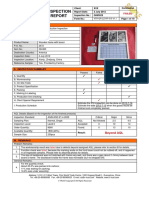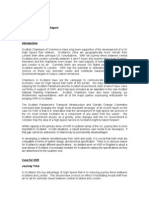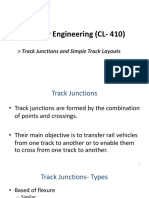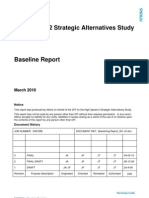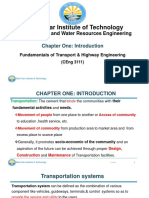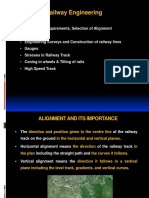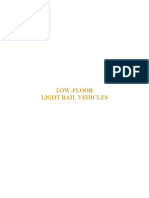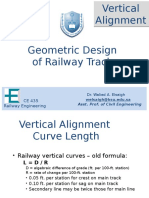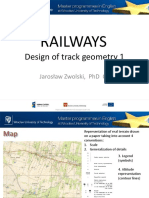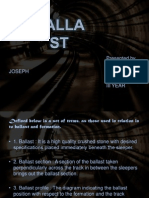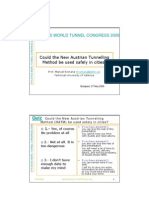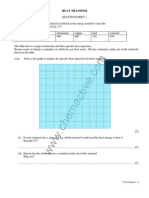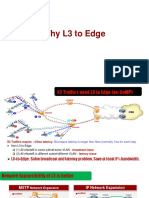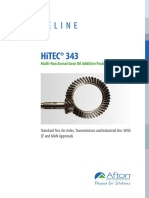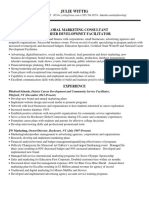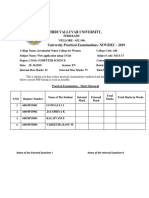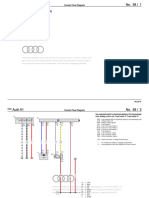0 ratings0% found this document useful (0 votes)
92 viewsRailway Track
Railway Track
Uploaded by
Hani HusainiRailway track consists of rails, fasteners, sleepers, ballast, and subgrade. Traditional track uses steel rails on timber or concrete sleepers laid on crushed stone ballast. This requires heavy maintenance. Ballastless track uses a continuous concrete slab to support rails, requiring less maintenance. Ladder track arranges sleepers along the rails' direction with cross members, existing in ballasted and ballastless forms. Functions of sleepers include maintaining rail gauge, absorbing loads, and supporting rails. Rails are made of steel and provide the running surface for trains.
Copyright:
© All Rights Reserved
Available Formats
Download as PPTX, PDF, TXT or read online from Scribd
Railway Track
Railway Track
Uploaded by
Hani Husaini0 ratings0% found this document useful (0 votes)
92 views20 pagesRailway track consists of rails, fasteners, sleepers, ballast, and subgrade. Traditional track uses steel rails on timber or concrete sleepers laid on crushed stone ballast. This requires heavy maintenance. Ballastless track uses a continuous concrete slab to support rails, requiring less maintenance. Ladder track arranges sleepers along the rails' direction with cross members, existing in ballasted and ballastless forms. Functions of sleepers include maintaining rail gauge, absorbing loads, and supporting rails. Rails are made of steel and provide the running surface for trains.
Original Description:
About the civil works of railway track
Copyright
© © All Rights Reserved
Available Formats
PPTX, PDF, TXT or read online from Scribd
Share this document
Did you find this document useful?
Is this content inappropriate?
Railway track consists of rails, fasteners, sleepers, ballast, and subgrade. Traditional track uses steel rails on timber or concrete sleepers laid on crushed stone ballast. This requires heavy maintenance. Ballastless track uses a continuous concrete slab to support rails, requiring less maintenance. Ladder track arranges sleepers along the rails' direction with cross members, existing in ballasted and ballastless forms. Functions of sleepers include maintaining rail gauge, absorbing loads, and supporting rails. Rails are made of steel and provide the running surface for trains.
Copyright:
© All Rights Reserved
Available Formats
Download as PPTX, PDF, TXT or read online from Scribd
Download as pptx, pdf, or txt
0 ratings0% found this document useful (0 votes)
92 views20 pagesRailway Track
Railway Track
Uploaded by
Hani HusainiRailway track consists of rails, fasteners, sleepers, ballast, and subgrade. Traditional track uses steel rails on timber or concrete sleepers laid on crushed stone ballast. This requires heavy maintenance. Ballastless track uses a continuous concrete slab to support rails, requiring less maintenance. Ladder track arranges sleepers along the rails' direction with cross members, existing in ballasted and ballastless forms. Functions of sleepers include maintaining rail gauge, absorbing loads, and supporting rails. Rails are made of steel and provide the running surface for trains.
Copyright:
© All Rights Reserved
Available Formats
Download as PPTX, PDF, TXT or read online from Scribd
Download as pptx, pdf, or txt
You are on page 1of 20
RAILWAY TRACK
LOCOMOTIVE
Typical Horsepower-per-net-ton Ratios
TRADITIONAL TRACK STRUCTURE
• Flat-bottom steel rails
supported on timber or pre-
stressed concrete sleepers
• Which are themselves laid
on crushed stone ballast
RAILWAY TRACK
Structure consisting of the:
1. rails
2. fasteners
3. railroad ties (sleepers)
4. ballast (or slab track)
5. underlying subgrade.
BALLASTLESS TRACK
• A disadvantage of traditional track structures
is the heavy demand for maintenance,
particularly surfacing (tamping) and lining to
restore the desired track geometry and
smoothness of vehicle running.
• Weakness of the subgrade and drainage
deficiencies also lead to heavy maintenance
costs.
• This can be overcome by using ballastless
track. In its simplest form this consists of a
continuous slab of concrete (like a highway
structure) with the rails supported directly on
its upper surface (using a resilient pad).
LADDER TRACK
• Ladder track utilizes sleepers
aligned along the same
direction as the rails with
rung-like gauge restraining
cross members. Both
ballasted and ballastless types
exist.
BALLASTED LADDER TRACK
• Minimizing the maintenance for
normal/tunnel sections or even
roadbeds in bad conditions.
• Solution for track irregularity at bridge
approach.
• Buckling free enabling continuous
welded rail at sharp curve .
• Substantial prolongation of surfacing
cycle at level crossing area.
FLOATING LADDER TRACK
• Minimizing vibration and noise.
• Shortening remarkably the
period of time necessary for
track installation work.
• Reducing construction cost for
viaduct by light-weight &
vibration reducing track.
FLOATING LADDER TRACK WITH CONCRETE BED
FUNCTIONS OF SLEEPERS
• Hold the rail to correct gauge
• Absorb blows and vibrations of moving loads
• Support the rail at proper level in straight track and proper super
elevation on curves
• Transfer load to wider area of ballast or girders in case of bridges
SLEEPERS
• Depending upon the position in a
railway track, sleepers may be
classified as:
• Longitudinal sleepers: consists of slabs
of stones or pieces of woods placed
parallel to and underneath the rails. To
maintain correct gauge of the track,
cross pieces are provided at regular
intervals.
• This type of sleepers are discarded
because:
• Running of the train is not smooth
• Noise created by the track is
considerable
• Cost is high
SLEEPERS (cont’d)
• Transverse sleepers: introduced in 1835
and are universally used. Remove the
drawbacks of longitudinal sleepers, i.e.
more economical, silent in operation and
running of the train over these sleepers is
smooth.
• Classified according to material used:
• Timber/wooden sleepers
• Steel sleepers
• Cast iron sleepers
• Concrete sleepers
RAILS
ADVANTAGES
1. Dependable:
a. most dependable mode of transport as it is the least affected by weather
conditions such as rains, fog etc. compared to other modes of transport.
2. Better Organised:
a. better organised than any other form of transport
b. has fixed routes and schedules
c. service is more certain, uniform and regular as compared to other modes of
transport.
3. High Speed over Long Distances:
a. speed over long distances is more than any other mode of transport, except
airways
b. best choice for long distance traffic.
ADVANTAGES
4. Suitable for Bulky and Heavy Goods:
a. Railway transport is economical, quicker and best suited for carrying heavy
and bulky goods over long distances.
5. Cheaper Transport:
a. cheaper mode of transport compared to other modes of transport
b. increase in the railway traffic is followed by a decrease in the average cost
c. economical in the use of labour, as one driver and one guard is sufficient to
carry much more load than the motor transport
d. stabilisation of prices
6. Safety:
a. safest form of transport
b. chances of accidents and breakdowns are minimum compared to other
modes of transport
ADVANTAGES
7. Larger Capacity:
a. carrying capacity is extremely large
b. capacity is elastic which can easily be increased by adding more wagons
8. Public Welfare:
a. largest public undertaking in the country
b. perform many public utility services
c. charges are based on ‘charge what the traffic can bear’ principle which helps the
poor
d. it is a national necessity.
9. Administrative Facilities of Government:
a. providing administrative facilities to the Government
b. defence forces and the public servants drive their mobility primarily from the
railways
10. Employment Opportunities:
a. provide greater employment opportunities for both skilled and unskilled labour
ADVANTAGES
11. Encourage commercial unity
a. products and goods are distributed to a larger area
b. Intra marketing of produce among regions
12. Development of nation
a. opening of remote areas to easier access towards development
13. Migration of population in mass scale
a. movement of population in large numbers from one place to another is
possible during times of crisis
14. Troops movement during war
a. Military personnel and equipment can be mobilised in large numbers at any
one time
15. Access to tourist attractions
a. Providing cheap and safe transportation for tourism
DISADVANTAGES
1. Huge Capital Outlay:
a. large investment of capital
b. cost of construction, maintenance and overhead expenses are very high compared
to other modes of transport
c. investments are specific and immobile
d. if traffic is not sufficient, the investments may mean wastage of huge resources
2. Lack of Flexibility:
a. Inflexibility - routes and timings cannot be adjusted to individual requirements
3. Lack of Door to Door Service:
a. cannot provide door to door service as it is tied to a particular track
b. intermediate loading or unloading involves greater cost, more wear and tear and
wastage of time
c. time and cost of terminal operations are a great disadvantage of rail transport
DISADVANTAGES
4. Monopoly:
a. as railways require huge capital outlay, they may give rise to monopolies
b. work against public interest at large
c. even if controlled and managed by the government, lack of competition
may breed inefficiency and high costs
5. Unsuitable for Short Distance and Small Loads:
a. unsuitable and uneconomical for short distance and small traffic of goods
6. Booking Formalities:
a. involves much time and labour in booking and taking delivery of goods
through railways as compared to motor transport
DISADVANTAGES
7. No Rural Service:
a. because of huge capital requirements and traffic, railways cannot be operated
economically in rural areas
b. large rural areas have no railway service even today
c. causes much inconvenience to the people living in rural areas
8. Under-utilised Capacity:
a. railway must have full load for its ideal and economic operation
b. as it has a very large carrying capacity, under-utilisation of its capacity, is a great
financial problem and loss to the economy
9. Centralised Administration:
a. being the public utility service railways have monopoly position
b. as such there is centralised administration
c. local authorities fail to meet the personal requirements of the people as
compared to roadways
You might also like
- IdroMOP EN 6.02.32 REV02Document26 pagesIdroMOP EN 6.02.32 REV02Service AgroMONDONo ratings yet
- TCRP Report 13Document204 pagesTCRP Report 13Bob DiamondNo ratings yet
- Slab Track Laboratory Test ProgramDocument92 pagesSlab Track Laboratory Test ProgramYuvita ValentinaNo ratings yet
- A GIS-Assisted Optimal Urban Route Selection Based On Multi Criteria ApproachDocument13 pagesA GIS-Assisted Optimal Urban Route Selection Based On Multi Criteria ApproachReynaldo AldamarNo ratings yet
- Sample Report - During Production Inspection PDFDocument19 pagesSample Report - During Production Inspection PDFg r100% (1)
- Od 113629804540443000Document1 pageOd 113629804540443000Nirupam SarkerNo ratings yet
- #3 Fundamentals-of-Safety-Design PDFDocument108 pages#3 Fundamentals-of-Safety-Design PDFJeremy Mark SorianoNo ratings yet
- Spot Speed StudyDocument4 pagesSpot Speed StudyGeniuskuga Kugas0% (1)
- High Speed Rail Report ScotlandDocument5 pagesHigh Speed Rail Report ScotlandHighSpeedRailNo ratings yet
- 6 Track JunctionsDocument18 pages6 Track Junctionsarpit089No ratings yet
- Preface 1. The Long Rail Laying, Installation / Maintenance Criteria (Proposal)Document23 pagesPreface 1. The Long Rail Laying, Installation / Maintenance Criteria (Proposal)lowryNo ratings yet
- Transporation Forecasting ProcessDocument53 pagesTransporation Forecasting ProcessVince AlanNo ratings yet
- Pandrol DFC - Operation & Maintenance ManualDocument20 pagesPandrol DFC - Operation & Maintenance ManualOon Chee Koon100% (1)
- Introduction To Railway Engineering PDFDocument114 pagesIntroduction To Railway Engineering PDFharshvardhan JhaNo ratings yet
- High Speed 2 Strategic Alternatives StudyDocument29 pagesHigh Speed 2 Strategic Alternatives StudyHighSpeedRailNo ratings yet
- 2.1 Pedestrian Vehicle Flow Motion StudiesDocument59 pages2.1 Pedestrian Vehicle Flow Motion StudiesMikealla DavidNo ratings yet
- Track Design Handbook TCRP - RPT - 155 2nd Ed. (2012) - Part7Document6 pagesTrack Design Handbook TCRP - RPT - 155 2nd Ed. (2012) - Part7linghuchongNo ratings yet
- CH 2 Railw-1Document49 pagesCH 2 Railw-1seyoum GNo ratings yet
- Chapter One - Fundamental of Transport and Highway EngineeringDocument30 pagesChapter One - Fundamental of Transport and Highway Engineeringmollalignm100% (1)
- RAILWAYS, History and Gauges - PPTDocument40 pagesRAILWAYS, History and Gauges - PPTUsman Afzal100% (1)
- Track Lateral ResistanceDocument19 pagesTrack Lateral ResistanceMarius DiaconuNo ratings yet
- 1.3 - Super Elevation Equilibrium Cant Etc.Document53 pages1.3 - Super Elevation Equilibrium Cant Etc.GishnuNo ratings yet
- Module #6 Railway Alignment Design and Geometry REES 2010Document35 pagesModule #6 Railway Alignment Design and Geometry REES 2010Muhammed AliNo ratings yet
- Geometric DesignDocument15 pagesGeometric DesignHanamant HunashikattiNo ratings yet
- Bridges PDF 1Document83 pagesBridges PDF 1Karmath budthapaNo ratings yet
- 11 5 9OotsSignalDesign PDFDocument250 pages11 5 9OotsSignalDesign PDFmigol116No ratings yet
- 2B - Fundamentals of Traffic FlowDocument16 pages2B - Fundamentals of Traffic FlowKwasi Agyeman-BoakyeNo ratings yet
- Introduction To HighwayDocument33 pagesIntroduction To HighwayLuisito RiveroNo ratings yet
- Transpo - Chapter 1Document12 pagesTranspo - Chapter 1nors lagsNo ratings yet
- Speed Spot StudiesDocument16 pagesSpeed Spot StudiesLuqman YusofNo ratings yet
- Railway QuizDocument66 pagesRailway QuizRam Kumar0% (1)
- Railways, Rail GaugesDocument45 pagesRailways, Rail GaugesabubakarNo ratings yet
- Trip Generation: The First Step in Transportation ForecastingDocument27 pagesTrip Generation: The First Step in Transportation ForecastingJohn BarrogaNo ratings yet
- Railway Engineering-3a - Permanent Way - Alignment & Engineering Surveys, Track SectionDocument48 pagesRailway Engineering-3a - Permanent Way - Alignment & Engineering Surveys, Track Sectionraghav Varma100% (2)
- Low Floor Light Rail Vehicles-Structural and Crashworthiness RequirementsDocument46 pagesLow Floor Light Rail Vehicles-Structural and Crashworthiness RequirementsHemant Chauhan100% (1)
- Railway Logistics of VietnamDocument22 pagesRailway Logistics of VietnamhoanglonguctNo ratings yet
- Che Railway Asignment IiDocument11 pagesChe Railway Asignment IiAbelo SetieNo ratings yet
- Tanzania - A Guide To Road Safety AuditingDocument34 pagesTanzania - A Guide To Road Safety AuditingFazelah YakubNo ratings yet
- Bridges Middle East 2009Document101 pagesBridges Middle East 2009Sheikh Nouman Mohsin RamziNo ratings yet
- Vertical CurveDocument10 pagesVertical CurveLarete PaoloNo ratings yet
- Traffic Volume StudiesDocument28 pagesTraffic Volume StudiesAnant AgarwalNo ratings yet
- Chapter 7 POINTS AND CROSSINGSDocument64 pagesChapter 7 POINTS AND CROSSINGSOtters ClubNo ratings yet
- RW 1Document83 pagesRW 1dilnessa azanaw100% (1)
- lectut-CEN-307-pdf-CEN 307 Geometric Design of Track Part 1 and 2 PDFDocument73 pageslectut-CEN-307-pdf-CEN 307 Geometric Design of Track Part 1 and 2 PDFama kumarNo ratings yet
- Rotary IntersectionDocument25 pagesRotary IntersectionZahid RahmanNo ratings yet
- Trip GenerationDocument24 pagesTrip GenerationAnthony Mark DulayNo ratings yet
- Curves - Concepts and Design Part-2 24 25-02-2015Document82 pagesCurves - Concepts and Design Part-2 24 25-02-2015Amitesh BajpaiNo ratings yet
- Railways: Design of Track Geometry 1Document27 pagesRailways: Design of Track Geometry 1inaNo ratings yet
- Test Methods Based On Relevant IS CodesDocument10 pagesTest Methods Based On Relevant IS CodesAnirudh SharmaNo ratings yet
- Lecture 4 Intersections Transportation EngineeringDocument38 pagesLecture 4 Intersections Transportation EngineeringIftikhar MughalNo ratings yet
- Transportation EngineeringDocument149 pagesTransportation EngineeringadeolaodukoyaNo ratings yet
- Presented by C.Kevin Joseph B.Tech (CIVIL) Iii YearDocument68 pagesPresented by C.Kevin Joseph B.Tech (CIVIL) Iii YearVetri VelanNo ratings yet
- Geometric Design Lect 6,7,8-2Document64 pagesGeometric Design Lect 6,7,8-2pritam BhowmikNo ratings yet
- Lecture 7A Traffic Signal DESIGN BasicsDocument23 pagesLecture 7A Traffic Signal DESIGN Basicsibtx1No ratings yet
- Austrian Tunneling MethodDocument20 pagesAustrian Tunneling MethodAnonymous knICaxNo ratings yet
- GCRC5633 Iss 2-Recommendations For The Risk Assessment of Buffer Stops, Arresting Devices and End Impact WallsDocument21 pagesGCRC5633 Iss 2-Recommendations For The Risk Assessment of Buffer Stops, Arresting Devices and End Impact WallsGeorge AlexiadisNo ratings yet
- Pasi Lautala, Michigan Tech University Tyler Dick, HDR, IncDocument33 pagesPasi Lautala, Michigan Tech University Tyler Dick, HDR, Incjason mr.perfect11No ratings yet
- New Track ConstructionDocument36 pagesNew Track Constructionpandabear_003No ratings yet
- Handbook of Railroad Construction; For the use of American engineersFrom EverandHandbook of Railroad Construction; For the use of American engineersNo ratings yet
- IBS in SarawakDocument5 pagesIBS in SarawakHani HusainiNo ratings yet
- Al IstisnaDocument8 pagesAl IstisnaHani HusainiNo ratings yet
- Simulation of IBS Formation For Housing Construction PDFDocument111 pagesSimulation of IBS Formation For Housing Construction PDFHani HusainiNo ratings yet
- Water TankDocument50 pagesWater TankHani HusainiNo ratings yet
- Principles of Islam in DesignDocument23 pagesPrinciples of Islam in DesignHani HusainiNo ratings yet
- Kemix Interstage-Screen-Brochure 2018 Rev1Document8 pagesKemix Interstage-Screen-Brochure 2018 Rev1evalenciaNo ratings yet
- hk00d 06-Db-Avn DD 1200-1800tb PDFDocument2 pageshk00d 06-Db-Avn DD 1200-1800tb PDFMadalina NituNo ratings yet
- MRP and CBP StepsDocument4 pagesMRP and CBP StepsRahul pawade100% (1)
- Gcse Physics: Heat TransferDocument25 pagesGcse Physics: Heat TransferYasin GüneriNo ratings yet
- Why IP RAN Is Better Than MPLS-TPDocument5 pagesWhy IP RAN Is Better Than MPLS-TPgo4adilNo ratings yet
- TN VCA Intelligent T WhitePaper EnUS 23419022347Document5 pagesTN VCA Intelligent T WhitePaper EnUS 23419022347Eric van LoonNo ratings yet
- Basic Electronics Syllabus OnlyDocument2 pagesBasic Electronics Syllabus OnlyBISHAL AdhikariNo ratings yet
- Invoice PDFDocument1 pageInvoice PDFDhingra shellyNo ratings yet
- Terra Aqua Gabion Gravity Retaining Wall Calculator Ver 1.0aDocument5 pagesTerra Aqua Gabion Gravity Retaining Wall Calculator Ver 1.0aveevimalNo ratings yet
- Course Description:: Gananoque Secondary SchoolDocument4 pagesCourse Description:: Gananoque Secondary Schoolapi-100040718No ratings yet
- IL NT 2 2 New FeaturesDocument39 pagesIL NT 2 2 New FeaturesAung MhNo ratings yet
- Ford Diesel 3-Cylinder Liquid-Cooled 201 Ci: (3.3 L) (112 X 112 MM)Document8 pagesFord Diesel 3-Cylinder Liquid-Cooled 201 Ci: (3.3 L) (112 X 112 MM)Alex CastilloNo ratings yet
- List of Executable File ExtensionsDocument11 pagesList of Executable File ExtensionsV'z SaNaToNo ratings yet
- 3.WMS-03 - Plain and Reinforced Cement ConcreteDocument17 pages3.WMS-03 - Plain and Reinforced Cement Concreteamol0% (1)
- Cessna 152 Normal Procedures v1.0Document2 pagesCessna 152 Normal Procedures v1.0gabi maquettesNo ratings yet
- HiTEC 343 PDSDocument2 pagesHiTEC 343 PDSMehmet PetronolNo ratings yet
- ILase Handpiece Calibration ProcedureDocument2 pagesILase Handpiece Calibration ProcedureTecnico BuhosNo ratings yet
- PLLDP BSCDocument6 pagesPLLDP BSCmounhacNo ratings yet
- This Answer Was Provided by CS Place, Click To Join The DiscordDocument2 pagesThis Answer Was Provided by CS Place, Click To Join The DiscordMetin KorkutNo ratings yet
- Product Datasheet: Interpon APP120Document4 pagesProduct Datasheet: Interpon APP120Vasudev BhanajiNo ratings yet
- Ncda ResumeDocument2 pagesNcda Resumeapi-446321851No ratings yet
- Thermochemical ConversionDocument31 pagesThermochemical ConversionerkiruthirajNo ratings yet
- Thiruvalluvar University,: Serkkadu VELLORE - 632 106Document6 pagesThiruvalluvar University,: Serkkadu VELLORE - 632 106parameshwari.s paapuNo ratings yet
- 787 Financial AnalysisDocument25 pages787 Financial AnalysisJason MakowskiNo ratings yet
- Ewd 58Document10 pagesEwd 58jonasNo ratings yet




